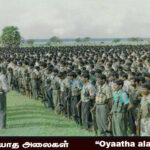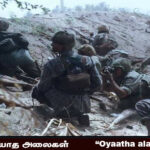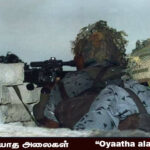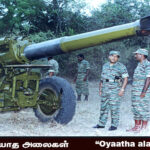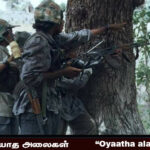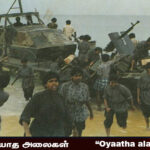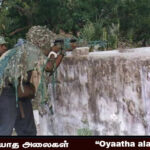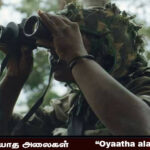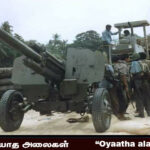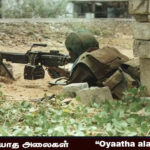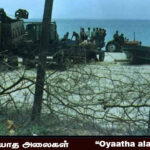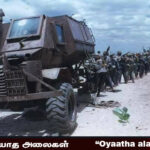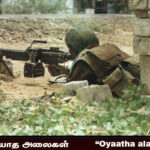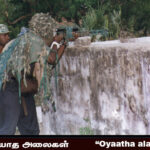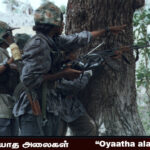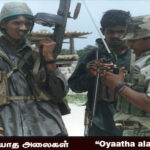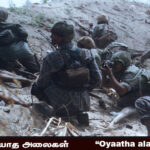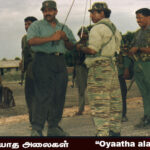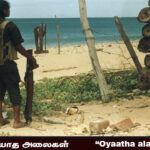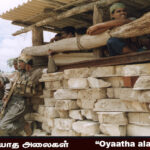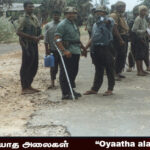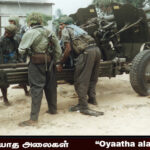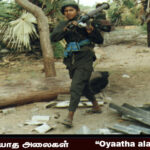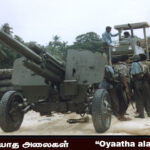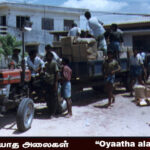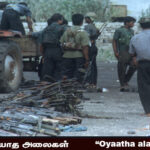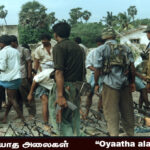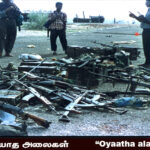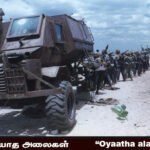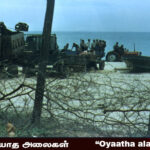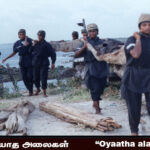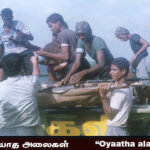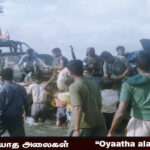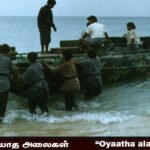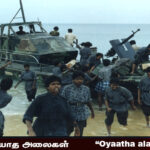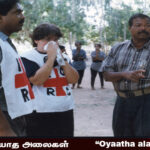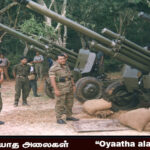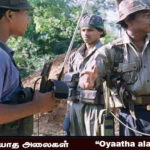

“Oyaatha alaikal”
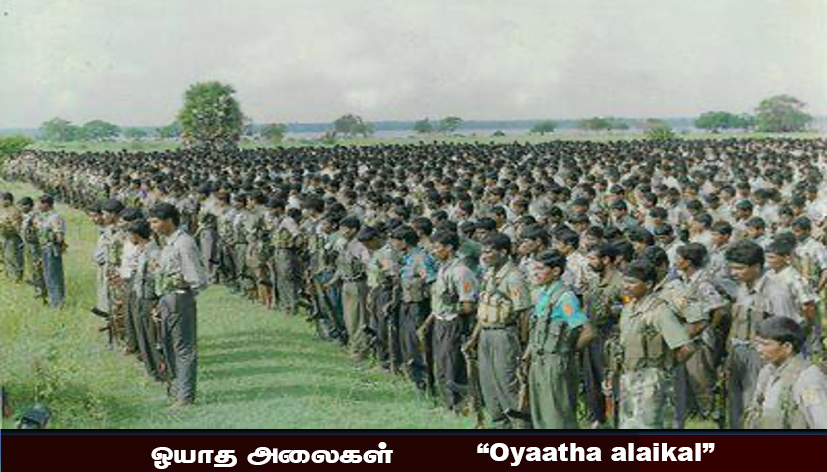
“Oyaatha alaikal”
In terms of the military dimension, there are some similarities between the “Oyaatha alaikal” military operation and the LTTE’s 1991 AGA (Agaya Sea) offensive. Both were massive military operations on two fronts – two different forms of fighting.
“Operation AGV” consisted of an Offensive on the Elephant Base and a Defensive to hold off the troops landed at Velilaikeni. Similarly, “Oyaatha alaikal” consisted of a military operation, an attack on the Mullaitheevu base, and a defensive attack on the commandos landed at Silawathai. However, the LTTE achieved complete victory in both the battles in the “Oyaatha alaikal”´s process. Destruction of the army in large numbers, seizure of arms and explosives in large quantities, thwarting the landing, restoration of land.
More than 1200 soldiers were killed in this attack, which can be recorded as a record in world military history. Such mass casualties as can occur in massive inter-state wars are rare in a guerilla-style surprise attack in a liberation war. In 1954, in Dinh Binh Phu (Vietnam) Battle, French forces suffered a similar devastation. But it is significant that the military blockade lasted for 56 days. 8,000 French soldiers died. However, a larger number of Vietnamese warriors were killed. A small number of warriors died heroically and killed many soldiers.
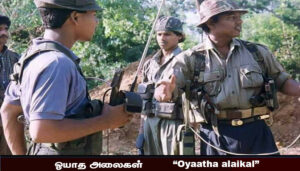
A special dimension of the Mullaithalam attack. Also, more than a thousand government soldiers were killed in the two-three-day battle, a remarkable military feat. Overall, there is no doubt that it is a heroic achievement that should be recorded in the book of Military Guinness. Compared to the number of soldiers killed in ”Operation Thavalai”, the number of soldiers caught in the “Oyaatha alaikal” is almost double. They will be shocked to know the news. However, the alarm among the soldiers is that the military leadership is at a loss to find out how this military destruction happened. This is the psychological dimension of the LTTE’s military victory in Operation “Oyaatha alaikal”. Also, the field situation became so complicated that the “Commando” troops sent to rescue the trapped soldiers inside the base had to be rescued! Timing was of the essence in the attack on the Mullaitheevu base.
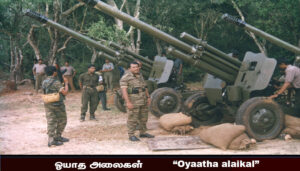
Radvattva’s arithmetical criticism that “70% of the LTTE” strength has been destroyed: We are going to destroy the remaining 30% in Vanni. Attracted attention both at home and abroad, at a time when the world was observing how the final chapter of the LTTE´s movement was going to be. The national leader Prabhakaran scored a major victory. Not only did he kill more than 1200 soldiers – the LTTE delivered a “shock treatment” to the Sinhalese mob, capturing a large quantity of explosives along with “Artillery” RCL, Pawal and 120mm motors and destroying a gun ship. The world was surprised when these stories were confirmed outside. Critics were silenced. They wondered how this military feat had happened and looked back through World War II history for comparison.
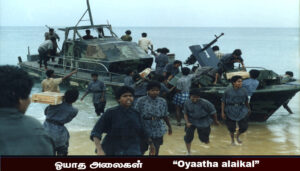 In 1968, a world journalist compared a large-scale attack by Vietnamese forces on American forces – called the Tet offensive – to the Mullai Island attack. One day, the Viet Cong movement suddenly launched a war against the main cities of South Vietnam, which were under the control of American forces. This was also called “Stone Attack”. Time played a very important role in this attack as well. It was a time when the American leadership was bragging that it had crushed the Viet Cong movement from South Vietnam: It was a time when the American people believed that it was all over. It was in that situation that, one morning, the Viet Cong fighters launched a massive conventional attack on the American positions called “Stone Attack”. This attack has given the American government a big political crisis.
In 1968, a world journalist compared a large-scale attack by Vietnamese forces on American forces – called the Tet offensive – to the Mullai Island attack. One day, the Viet Cong movement suddenly launched a war against the main cities of South Vietnam, which were under the control of American forces. This was also called “Stone Attack”. Time played a very important role in this attack as well. It was a time when the American leadership was bragging that it had crushed the Viet Cong movement from South Vietnam: It was a time when the American people believed that it was all over. It was in that situation that, one morning, the Viet Cong fighters launched a massive conventional attack on the American positions called “Stone Attack”. This attack has given the American government a big political crisis.
Similarly, the attack on Mullai Island took place at the time when the Sinhalese government had declared that “the story of the LTTE is over”. However, there is a political and although there are similarities in the psychological dimensions, there are many differences in the military dimension. It is true that the “Stone Attack” overwhelmed the US forces; But within a few days, the US forces repulsed the invasion. So, the “Stone Offensive” did not bring victory to the Viet Cong movement militarily.
But the “Oyaatha alaikal” operation has also given the LTTE a massive military victory – along with political and psychological dimensions. Unlike the “Reth attack”, here the target of the attack was completely captured by the LTTE. They completely destroyed the Sinhalese army there. They captured the weapons and furniture of the enemy. They also recovered the land occupied by the enemy. The comparison of the foreign correspondent who linked the “Stone Attack” with the “Oyaatha alaikal” attack is superficially perfect.
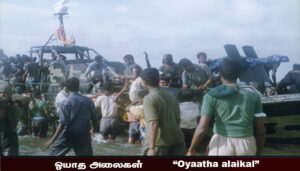 However, the military dimension of the “Oyaatha alaikal” attack can be compared in some respects with the Japanese attack on the Pearl Harbor in 1941. The daring – and surprising – attack by the Japanese forces during its impenetrable security holds a place in military history. Compared to the nature of the attack and the destruction it inflicted on the enemy, the “Pearl Harbor” attack is comparable to some of the military aspects of Operation “Oyaatha alaikal”.
However, the military dimension of the “Oyaatha alaikal” attack can be compared in some respects with the Japanese attack on the Pearl Harbor in 1941. The daring – and surprising – attack by the Japanese forces during its impenetrable security holds a place in military history. Compared to the nature of the attack and the destruction it inflicted on the enemy, the “Pearl Harbor” attack is comparable to some of the military aspects of Operation “Oyaatha alaikal”.
Last year (1995), the LTTE suffered several military setbacks. Due to this, the liberation struggle came to a standstill. In all the cases where the “struggle wagon” was buried, the national leader Prabhakaran himself has carried out the historical responsibility of pushing the struggle wagon forward. The leader worked hard to shift the balance of power in favor of the Tamils by launching a massive offensive – deciding to create that balance by destroying the Mullaitheevu military base.
The leader also knew what would happen to the struggle if the attack on Mullaithalam, which had already suffered a series of military losses, gave the LTTE a military setback. Therefore, he needed to ensure 100% success of the attack and thus the leader took full responsibility of the attack. Training for the attack, medical training for the battle, preparations for the supply needs and relocation of the attack forces. He kept all the work related to the attack under his direct supervision. He also carried out the attacks exactly as planned – ensuring complete secrecy regarding the attack. And the brilliant offensive scheme was the backbone of the victory. At the same time, the speed and surprise shown during the attack contributed to the victory. In this way, the victory of the “Oyaatha alaikal” gave confidence to the tired Tamil people and led to the increase in the armed forces of the LTTE.
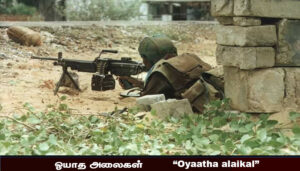 By planning and conducting this massive attack, the national leader Prakhakaran has achieved a historic victory for the Tamil party. The number of soldiers killed in “Oyaatha alaikal”, as well as the types and amounts of weapons captured there, have given fresh energy to the struggle. First, two medium-range (15km-capable) “artilleries” have arrived in the hands of the LTTE. As well as R.C.L. and 120mm (five-inch) motors along with their projectiles have also been captured in significant quantities. These captured conventional weapons have greatly aided the LTTE’s efforts to become a traditional force. With these weapons – in the future – leader Prabhakaran can be expected to perform many miracles in the war. Apart from the military dimension like the types of weapons captured, the number of soldiers killed, the “Oyaatha alaikal” military operation will also hold a special place in the history of the war between the Sinhalese and the LTTE.
By planning and conducting this massive attack, the national leader Prakhakaran has achieved a historic victory for the Tamil party. The number of soldiers killed in “Oyaatha alaikal”, as well as the types and amounts of weapons captured there, have given fresh energy to the struggle. First, two medium-range (15km-capable) “artilleries” have arrived in the hands of the LTTE. As well as R.C.L. and 120mm (five-inch) motors along with their projectiles have also been captured in significant quantities. These captured conventional weapons have greatly aided the LTTE’s efforts to become a traditional force. With these weapons – in the future – leader Prabhakaran can be expected to perform many miracles in the war. Apart from the military dimension like the types of weapons captured, the number of soldiers killed, the “Oyaatha alaikal” military operation will also hold a special place in the history of the war between the Sinhalese and the LTTE.
Its special importance is since the LTTE thwarted the Sinhala government’s tri-armed sea-air landings. This incident is sure to be a milestone or a steppingstone in the history of the armed struggle for the liberation of Tamil Eelam.
The auxiliary force is like blood circulation in conventional warfare. It is this auxiliary force that infuses new energy into the crisis-ridden military bases and protects them. This auxiliary force, consisting of “commando” troops, landed at Silawatta by naval and air force, could not achieve its goal – the development of the LTTE’s legacy of war, which caused it to go back the way it came from, would have caused great concern to the Sinhalese nationalist military forces.
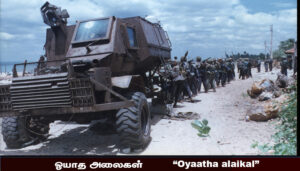
It can be grouped into categories. One is the “commando” style landing and the other is the traditional landing. The “commando” style landing is also by sea, can also be done by air. This type of attack is based on surprise, and the landing is done in secret. A brave state of being in this kind of landing; The number of soldiers involved will also be minimal; Such attacks are carried out to do some sabotage or target someone or destroy a small military position, but the military dimension is complete with the minor loss of the “commandos” in question.
The military leadership concerned would not worry much about such a loss, but conventional landings are quite the opposite. The objectives of such landings are massive military objectives to capture territory or rescue a threatened military base.
Failure of such attempts can result in massive casualties and loss of weapons. It will also show the military reality of the strength of the government forces and its opposing forces. No one can deny that the Sinhalese force has failed to achieve its objective of landing. Because of this, the government’s military policy of staying on the sea – relying on landings to protect the Northern Army camps – is now facing a challenge.
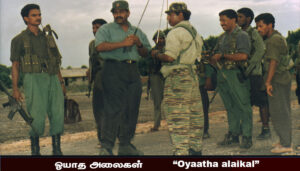 The government forces made the landing in the face of counter-attacks launched by the LTTE both in the air and on the sea. However, the soldiers were unable to penetrate the LTTE army, which stood like a barrier in front of the landed Sinhalese special forces. The day after the attack on Mullaithalam began (18th) in the evening, a team of the auxiliary force was landed. And very close to the base – about two kilometers away – they landed. These are not ordinary soldiers. Commando trained special forces are combat experienced commandos. In their movement towards the base, the Navy and Air Force helped them, but their attempt was unsuccessful. That is how the LTTE’s ground offensives were. In 1991, what they could not do on the Wetlaikenik beach, the LTTE did in Silawatha – five years later.
The government forces made the landing in the face of counter-attacks launched by the LTTE both in the air and on the sea. However, the soldiers were unable to penetrate the LTTE army, which stood like a barrier in front of the landed Sinhalese special forces. The day after the attack on Mullaithalam began (18th) in the evening, a team of the auxiliary force was landed. And very close to the base – about two kilometers away – they landed. These are not ordinary soldiers. Commando trained special forces are combat experienced commandos. In their movement towards the base, the Navy and Air Force helped them, but their attempt was unsuccessful. That is how the LTTE’s ground offensives were. In 1991, what they could not do on the Wetlaikenik beach, the LTTE did in Silawatha – five years later.
This historical incident points to the development of the LTTE movement in traditional ground warfare. Due to the failure of the Silawatha landing, anyone can make the wrong conclusion that the government forces will dare to carry out a conventional landing in the future. However, the Sinhalese generals will not deny that such landings will be like a game of gambling.
It is an incomprehensible puzzle that the operations of “Suryakathir” – 1E 2E 3E have crushed the fighting ability of the LTTE movement, not only the opinion of the Sinhalese government, but also most of the world military and political analysts considered the same. They have commented that the LTTE can only carry out small attacks. In short, most of the analysts have said that the current military strength of the LTTE will allow them to carry out a low intensive warfare. But all such military calculations and military impressions were drowned by the “Oyaatha alaikal”.
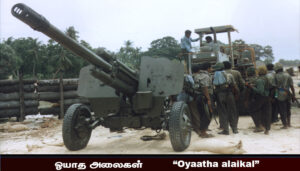
They can’t understand the actions of the LTTE who retreated without a fight in South and North. Even with the news of that the LTTE has captured the Mullaithalam back, they did not understand the LTTE. The LTTE movement has awakened to the fact that it cannot be understood. The LTTE movement remains an enigma to the military world.
The characteristics of leader Prabhakaran’s military operations have given the LTTE movement such mysterious characteristics. The main reason why contemporary analysts are unable to correctly predict the military evaluations of the LTTE movement is the military criteria held by that analyst.
Apart from this, Prabhakaran’s military ideas and actions were largely unique. Due to this, Prabhakaran’s war art cannot be accurately measured and predicted using the military criteria he has. Therefore, the opinions of military critics about the LTTE Movement are often exaggerated. The day when Leader Prabhakaran gives the world a detailed explanation of his war tactics, the mystery of the LTTE Movement will be solved!
